MFA Products of Design 2024
School of Visual Arts


MFA Products of Design 2024
School of Visual Arts































Copyright © 2024 by
Rui YangAll rights reserved. No part of this book may be reproduced or used in any manner without the prior written permission of the copyright owner, except for the use of brief quotations in a book review.
For inquiries, contact ryang6@artic.edu
School of Visual Arts MFA Products of Design 136 West 21st Street New York, NY 10011-3213
productsofdesign.sva.edu
serif typeset in ABC Arizona
sans-serif in Camera Plain by Dinamo Typefaces
Printed by Blurb
Chapter 6
Audience
Chapter 7
Thesis Projects
Thought Matrix Kong Blocks
Drifting Canvas
Unity Canvas
Chapter 8
Looking Forward
More
Bibliography Image Sources Thanks.


I remember my first enlightenment about art. I was about five years old, casually flipping through a book in the library, and came across a painting of water lilies. The beauty of the painting gave me a sense of expansiveness, a feeling of understanding something new. I looked at it for a long time but couldn’t discern the materials used in the painting, because back then, I had only used colored pencils and crayons. Later, I ran back home, and before I forgot it, I used crayons to sketch the water lilies from my mind. Three summers later, I learned from my teacher that the artist of that painting was Claude Monet.
I like such serendipitous encounters, first appreciating an artist’s works, and then learning about their reputation. Their fame is not important to me. I am not moved when someone tells me, “You must read this book in your lifetime,” and then after reading it, I feel obliged to agree with everything in it just because it was written by someone famous. Rather, I’m drawn to the message the writer wants to convey, regardless of their level of renown.
I prefer to think for myself.
But thinking for oneself isn’t easy, especially in the age of smartphones.


A 16-year-old girl is distracted by her constantly vibrating phone while in class, unable to concentrate on the lesson. Each notification reminds her of the current most popular styles, coolest behaviors, and most popular celebrities. She checks these messages one by one, worried that missing them will make her feel left behind by the trends, even though she sometimes feels that this information takes up too much of her time. After class, on her way home, she is attracted by a beautiful painting on a poster outside an art gallery. The painting briefly captures her attention, so she takes a photo of the poster, planning to look up the artist's work when she gets home.
However, once home, she is again drawn to videos and social media messages on her phone, and time slips away unnoticed. After browsing through this content, she receives a message from an online friend about a popular book. Although she has heard of the book, she has not read it. To discuss it with the online friend, she decides to first read some popular book reviews. After reading the reviews, she feels satisfied and responds to the online friend with those opinions about the book. It is not until she lies in bed that she realizes she spent the whole day browsing other people's opinions, yet she feels empty inside.
After a day of information overload, she feels numb. She vaguely remembers there was a moment today that briefly refreshed her mind, but she can't recall what it was.
Ideological segregation in Echo Chambers is a phenomenon that limits young adults' exposure to diverse thoughts and reduces their motivation for proactive thinking. Meanwhile, teenagers might record their ideas but forget to revisit them, leading to missed opportunities to recognize and value their insights. Adolescents are still in the learning phase; they are growing but have not yet reached maturity. This stage also affects their judgment in future decision-making, which requires the support of critical thinking. Why is critical thinking important? Because it enables individuals to analyze information objectively, consider different perspectives, and reflect on their values and beliefs rather than relying on assumptions or biases. Critical thinking is not just a tool for logical analysis; it also helps people connect with and understand their emotions.
Why does passively relying on others’ information harm critical thinking? Critical thinking is inherently emotive, beginning with instinctive reactions. As Peter Thomas suggests, our first reaction should be as human beings – emotional, reactive, and instinctive – before we become rational, logical, or intellectual1. By habitually accepting others' thoughts without question, we lose the impetus for proactive, independent thinking. If teenagers continue relying solely on online information, they risk reducing their capacity for proactive thinking and losing motivation.
My thesis, Echoes of Autonomy: Investigating Strategies to Enhance Independent Thought, presents strategies aimed at fostering independent thinking, underscoring the value of embracing diverse viewpoints as a crucial escape from the echo chamber. I have developed a range of design solutions, encompassing digital platforms designed to engage users in decision-making and learning through contrasting perspectives, physical objects that showcase interactions and achievements from the digital platform, experiences aimed at exploring people's vulnerabilities and enhancing creativity, a service platform transforms creative experiences into equitable shared value over time and space, benefiting multiple stakeholders.
In the context of social media and echo chambers, users are exposed to information that may challenge or reinforce their existing beliefs. The ability to critically assess and reflect on this information is significant in avoiding undue influence from biased or one-sied perspectives.
How can we develop collaborative platforms that encourage diverse backgrounds to share and learn from a wide range of information?
Information compression produces the maximum profit in corporate AI, but from a social perspective, it produces higher discrimination and a loss of cultural diversity.
Garcia, P., & Truong, T. (2023, March 6)1
We were seeing what our accepted frames encouraged us to see. Or encouraged us not to see, as was more often the case. We were far from alone in that myopia. What we missed, what so many other people missed, and more importantly why we missed it, emerged from something deeper than the digital tools we were using and deeper than the platforms we were posting on. Our fetishized sight emerged from yet another outcropping of liberalism and the Enlightenment before that: structural white supremacy. Or described another way, freedom for white people: white lives, white liberty, and the pursuit of white happiness at the expense of everyone else.(p.63)
Phillips, W., & Milner, R. M. (2021)2
1. Garcia, P., & Truong, T. (2023, March 6). How we used Barbie dolls to hack AI bias. Medium.
2. Phillips, W., & Milner, R. M. (2021). You Are Here A Field Guide for Navigating Polarized Speech, Conspiracy Theories, and Our Polluted Media Landscape. The MIT Press.
Over time, overreliance on digital nudging to manage misinformation on social media newsfeeds could contribute to users subjected to this measure becoming “more dependent on decisional support” from the respective implementing platform(s).
Scott, R. M. (2023)3
Susser et al. (2019, p. 3) argue that “at its core, manipulation is hidden influence - the covert subversion of another person’s decision-making power”. This can be done by “exploiting the manipulee’s cognitive (or affective) weaknesses and vulnerabilities in order to steer his or her decision-making process towards the manipulator’s ends” (Susser et al., 2019, p.3). (P. 15)
Sahebi, S., & Formosa, P. (2022)4
3. Scott, R. M. (2023). MANAGING MISINFORMATION ON SOCIAL MEDIA: TARGETED NEWSFEED INTERVENTIONS AND FREEDOM OF THOUGHT. Northwestern Journal of International Human Rights
4. Sahebi, S., & Formosa, P. (2022). Social media and its negative impacts on autonomy. Philosophy & Technology
Speaking to The Irish Times, she encourages people “to be self-reflective and say: am I really in control here, or am I being led here? And it’s not their fault if they feel like they are not in control because the platforms and the devices they run on are designed to co-opt their attention.”
“One needs only to look over the shoulder of some people these days to see the imagery social media algorithms suggest: eating disorders, macho masculinity, self-harm, soft porn. It doesn’t take long to get from doomscrolling corecore
5. Should anxious teenagers be banned from using social media?: Evidence linking social media use to depression continues to mount, but experts disagree about how best to respond.
6. On the internet, there’s a fine line between fun and manipulation: There is something deeply problematic going on if young people are flocking to social media to experience emotional connection.
We live in an era of information overload. The ways of knowledge dissemination have evolved from spoken word to written text, to images, and now to digital screens. Faced with the myriad of choices in everyday life, can we actually make decisions? Often, an excess of options makes it difficult for us to decide. In such cases, can we still take action? In fact, we often choose to give up the right to make our own choices, allowing others to decide for us.
These major media platforms take up a lot of our time. While we use these platforms for free to access information, they push advertisements and topics of potential interest to us using the personal information we provide. This is a wellworn topic. The reason I mention it again is because it seems we have become accustomed to this state of affairs.
Echo chambers are affecting adolescents’ behaviors and thinking processes. Ideological Segregation in Echo Chambers This phenomenon limits adolescents’ exposure to diverse thoughts and reduces their motivation to think proactively.
The technologies and social media platforms shape our perception of self and influence our autonomy. Whether our interactions with technology align with our genuine selves or if they are swayed by algorithmic suggestions and societal pressures.
The manipulation of information and the exploitation of cognitive vulnerabilities by algorithm-driven platforms jeopardize the freedom of thought and the integrity of decision-making processes.
1. We could broaden adolescents’ exposure to diverse content and enhance their critical thinking abilities, fostering a more open and reflective approach to information consumption and interaction in digital spaces.
2. We could have a conscious effort to navigate the digital landscape with a sense of self-direction and an openness to questioning the influence of technology on our identity and beliefs.
3. If adolescents have a secure, comfortable, and nurturing space that lets them to share their thoughts, they can enhance their ability for proactive thinking.


The workshop aimed to explore the influence of echo chambers on human behavior and the potential of AI in promoting diverse thinking. It targeted social media users and art students, focusing on maintaining autonomous thinking amidst prevalent echo chambers.
In the current era, characterized by echo chambers, there is a noticeable increase in ideological segregation, underscoring the fostering of free thought. Critical thinking is not just a tool for logical analysis but also plays a pivotal role in helping individuals connect with and understand their emotions. Furthermore, the presence of preconceived notions can often impede our capacity for genuine reactions which emphasizes the need for open-mindedness in our thought processes.






Participant Profile:
Social media users and art students.
Individuals interested in the intersection of AI, and creativity.
Goal:
To understand how echo chambers affect human behavior.
To explore how design can encourage diverse thought processes.
To investigate the role of AI in enhancing self-awareness and connection with others.
Questions about AI and Creativity:
Participants shared varied perspectives on AI’s role in their creative process, from aiding in exploration to concerns about AI’s mechanical nature and lack of emotional appreciation.
Verses Transformed - AI Translation:
Multi-translated poems revealed humor and inconsistency, questioning AI’s reliability in preserving artistic essence. AI was perceived as professional but lacking in emotional depth.
Echoless Realms - Unconstrained World:
Participants enjoyed visualizing a world free from filter bubbles, resulting in diverse, instinct-driven artwork. The activity highlighted individual creativity and inner selfreflection, with no overlaps in content, also expressed the value of unrestricted thought processes.

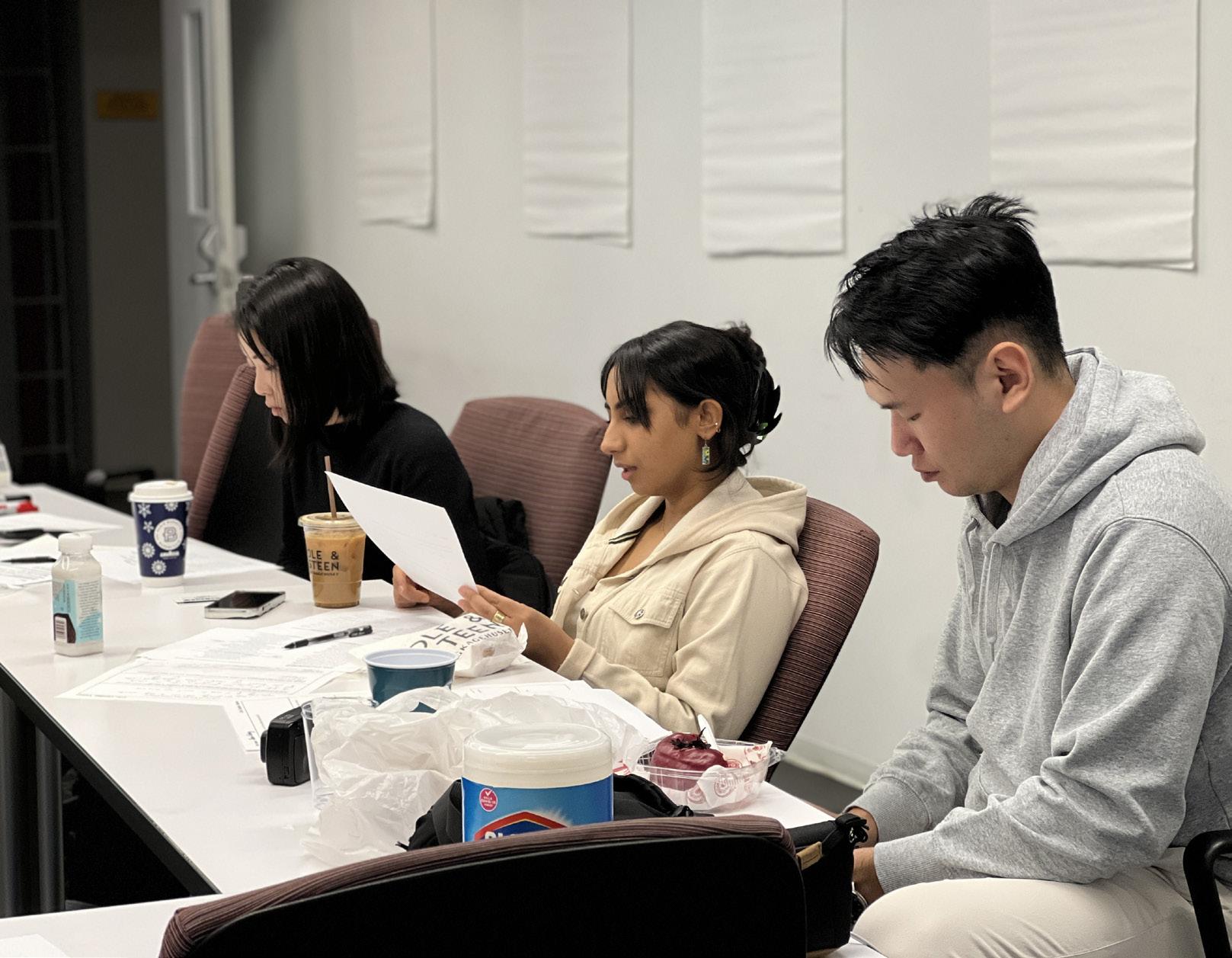






Were there any surprising insights or interpretations that emerged from reading these multi-translated pieces?
1. “The original poems were abstract but understandable and could be previewed in any way from our understanding, but the translation was so funny and scary.”
2. “Hard to keep attention- inconsistent.”
How do you feel about the unpredictability and randomness of AI in the context of artistic expression?
1. “It sounds more professional, but the context itself might be hollow.”
2. “AI is never going to be able to replace true artistry in any opinion.”
3. “AI itself is not capable of appreciating emotions.”
4. “I think it’s very scary personally because it’s not what we expect. But then we consume it as we get it. It was maybe meant to be challenging but it has become a fool of information overload.”


Nowadays, echo chambers and new technologies like AI significantly impact us, and the thinking process seems a bit ‘inefficient’, especially in this era of instant gratification. What echo chambers bring is the growing ideological segregation.
I am exploring collaborations with new technologies to reclaim the autonomy of thinking.
Ideological Segregation in Echo Chambers This phenomenon limits adolescents’ exposure to diverse thoughts and reduces their motivation to think proactively.
“A study conducted by Marchi (2012), found that teenagers disavowed the concept of ‘objectivity’, and instead gravitated towards news circulated primarily by entertainment companies that offered commentary, satire, or opinion pieces on current events.”
Parker, Lana and Kristy Smith1
Opportunity: Young people are not only absorbers of information but also creators. Assisting them in developing everyday thinking skills is the first step in awakening proactive thinking. Exploring a convenient method to help them record and reflect on their ideas.
1. Parker, Lana and Kristy Smith. “Literacy Education in the Post-Truth Era: The Pedagogical Potential of Multiliteracies.” Language and Literacy / Langue et litteratie
2. P. Thomas, School of the Art Institute of Chicago, Instructor, October 27, 2023

“I think students need to learn to trust their own reactions, rather than think, ‘I should be reacting the way that person has.’”
Peter Thomas2Young adults should trust their instincts, instead of feeling compelled to conform to others’ responses.
How might we design a product that encourages young adults to record and revisit their daily thoughts that helps them to value their reactions?
If adolescents have a secure, comfortable, and nurturing space that lets them share their thoughts, they can enhance their ability for proactive thinking.
How might we design an app for adolescence (age 15-24) that encourages them to value their thoughts by examining their daily experiences, therefore establishing the motivation for autonomy thinking?
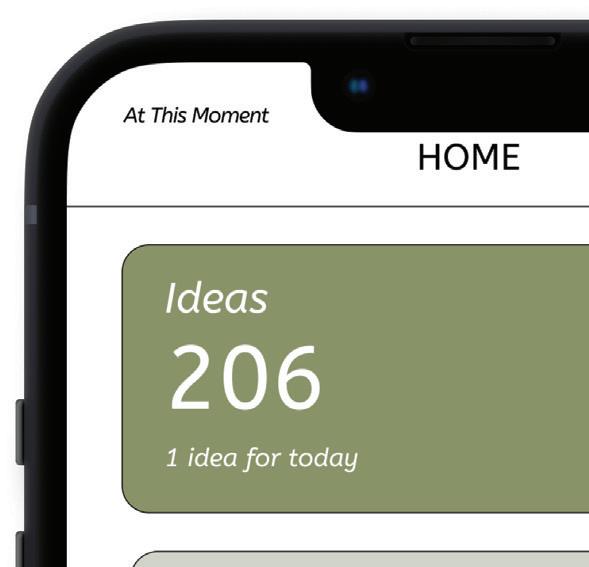



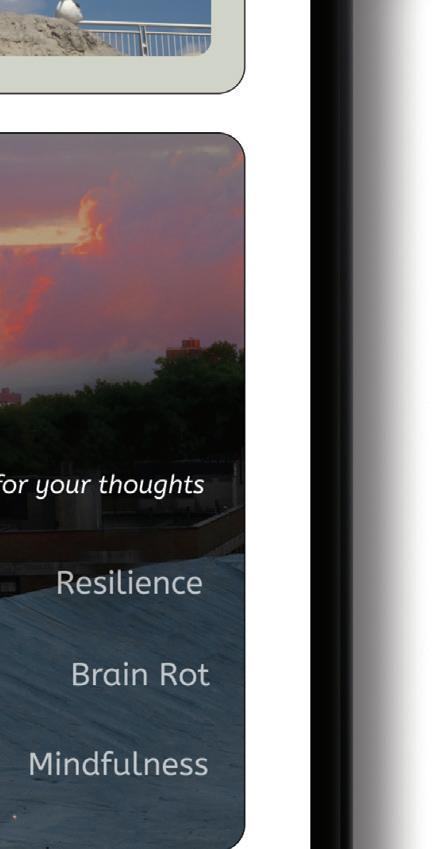

At This Moment is an app that helps users to record and revisit their thoughts. Users can build a personal information library by reviewing where and when they had certain questions or inspirations.
Teenagers, Young adults age from 15 to 24
At This Moment was designed for adolescents who are navigating the complexities of forming personal ideologies. It’s also beneficial for educators and parents seeking to foster autonomous thinking in young adults.
Recording page



Users can simply shake their phones to activate the record button, allowing them to quickly capture their thoughts before inspiration fades. The system will automatically convert the voice recording to text and save it in the app.










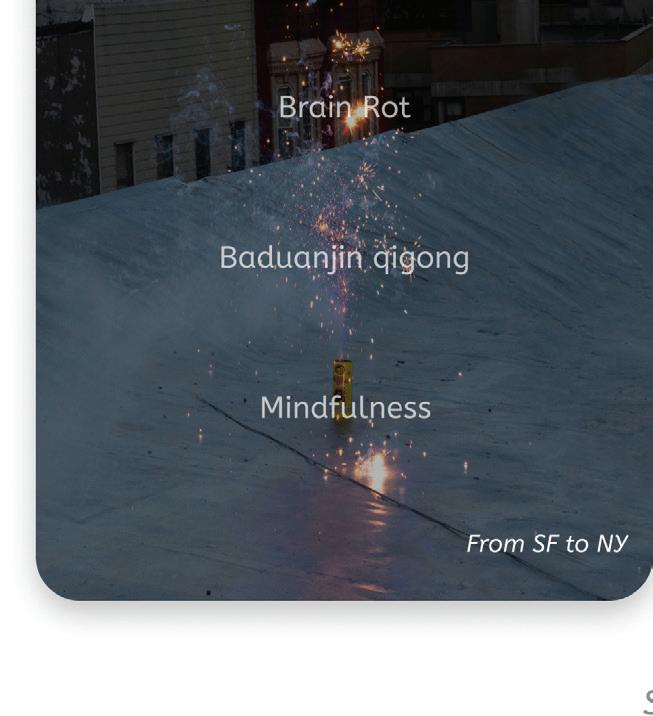




page














































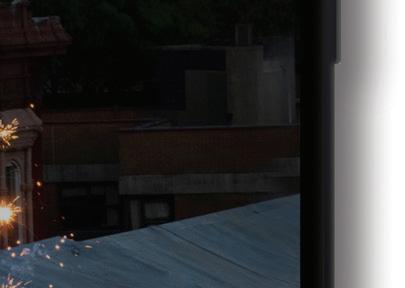





In this personal and safe space, users can express their ideas and questions. The system will collect that information, then organize related articles for browsing, and also periodically deliver them to the users. Users can build a personal information library here. The app aims to break the cycle of passive consumption of ideologically aligned information. Actively engaging users in the process of recording and reflecting on their thoughts, encourages a more proactive approach to thinking.
Some new concepts to enhance the app’s design:
Al-Powered Analysis: This feature leverages artificial intelligence to scrutinize user entries, uncovering patterns, biases, and recurring themes. Its goal is to help users break free from their ideological echo chambers by providing insightful analysis.
Reflective Prompts: To foster proactive thinking, the app generates customized prompts. These encourage users to reevaluate their views or explore their ideas more profoundly, thereby deepening their understanding and perspectives.
Community Sharing (Optional/Anonymous): This option allows users to share their thoughts with a peer community either openly or anonymously. It’s designed to cultivate a rich, diverse exchange of ideas and viewpoints, enriching the user experience.
Additionally, I’m keen on exploring the creation of collaborative spaces where individuals from diverse backgrounds can create and learn from varied information.


We instinctively reach for our phones and mindlessly open apps like Instagram or TikTok, slipping into a cycle of doomscrolling without even realizing it, we’ve become accustomed to this state of affairs.
We have been deprived of our choice without realizing it. This passive state of consuming information resembles being one of the helpless blind in José Saramago’s novel Blindness— hopelessly and passively blind.
We have no choice.
“I don’t think we did go blind, I think we are blind, Blind but seeing, Blind people who can see, but do not see.”
José Saramago1These platforms and products have shaped our habits. I believe many of you here have experienced a time before smartphones. Compared to that era, we can clearly feel that although we now access information more quickly, the connection to a deep understanding of knowledge has become increasingly severed. It appears that we are being trained by the torrent of the times to merely be receptacles for receiving information, and our critical thinking is affected as a result.
Regarding the impact of social media on people’s critical thinking and the importance of autonomous thinking, I have read a series of articles and books, listened to relevant podcasts and videos, also interviewed experts in various fields.
1. José Saramago p. 126 - Blindness (1995)



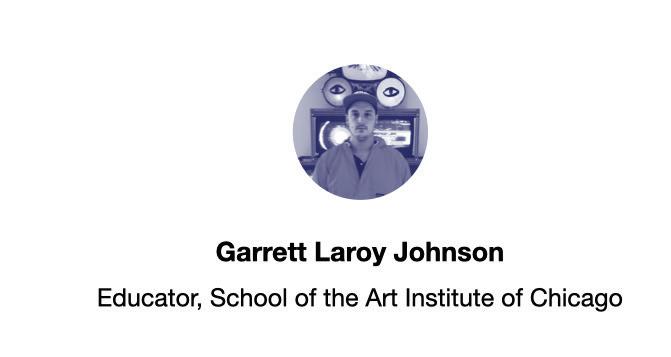




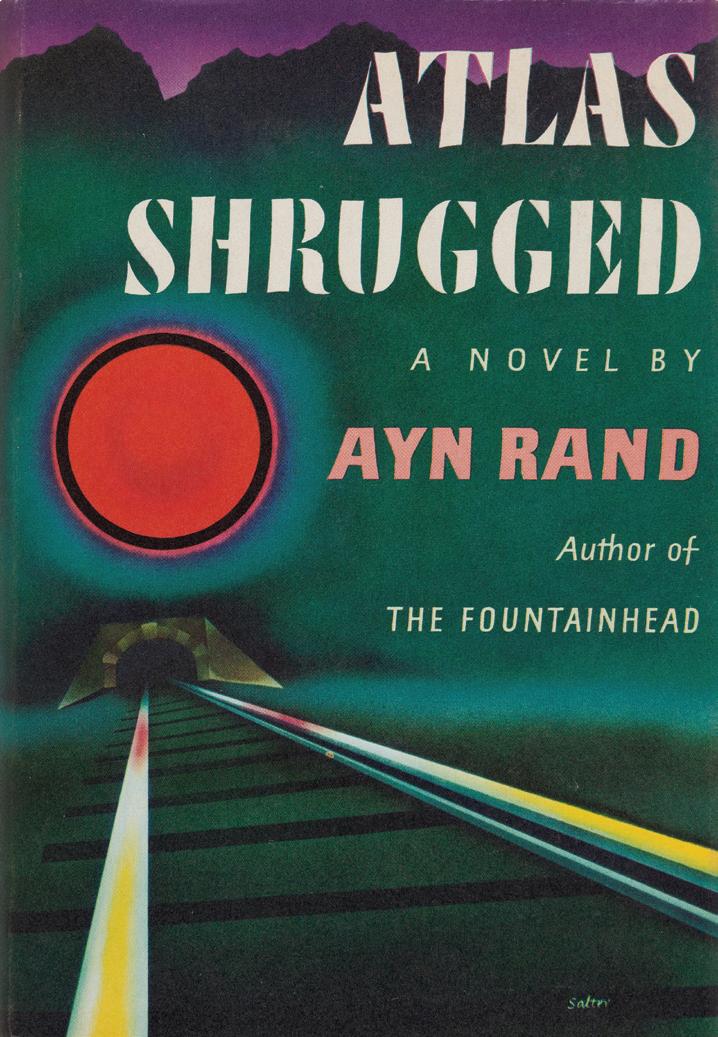






1 InstituteforEducationalTechnology,NationalResearchCouncilofItaly,90100Palermo,Italy; davide.taibi@itd.cnr.it(D.T.);giovanni.fulantelli@itd.cnr.it(G.F.)
2 DepartmentofHumanSciences,LUMSAUniversity,90100Palermo,Italy

Socialmediahasaveryimportantroleinadolescents’dailylife,providingthemwithmeans forcommunicating,sharing,representingthemselvesandcreatingandmaintainingrelationships. However,socialmediacanhiderisksfortheuserswhichcanunderminetheirmentalwell-being, especiallyamongstadolescents.Theexploratoryresearchpresentedinthispaperaimsathighlighting therelationshipsbetweentheconscioususeofsocialmediabyadolescentsandtheirpsychological well-being.Inparticular,wepresentapilotstudyinvolvingN=80adolescents(age16–20),which wasdesignedtoanalysetheconstructsofmentalwell-being,lifesatisfactionandresilienceinrelation tothecapacityofadolescentstousesocialmedia.Adolescentswererandomlydividedintoan experimentalgroupandacontrolgroup.Theexperimentalgroupattendedasocialmedialiteracy courseaimedatraisingparticipants’awarenessofthebenefitsandpitfallsofsocialmedia.The Mann–WhitneyUtesthasbeenusedtoassessstatisticallysignificantdifferencesbetweenthetwo groupswithrespecttotheageandtheconstructsunderinvestigation.However,thetestreported >0.05).Wearguethatstatisticallysignificantdifferencescould beobservedbyinvolvingalargersamplesize.Thisseemstobeconfirmedbythelowvalueofthe poweroftheaposterioritestforallthevariablesconsidered.Inthissense,ourpilotstudypaves thewayfornewresearchaimedatinvestigatingtheimpactofSocialMediaLiteracyonadolescents’

Received:17June2023
Revised:8August2023
Accepted:17August2023
Published:23August2023

trainingschoolactivities;socialmediaeducation;adolescence;socialmediathreats Medialiteracyistheabilitytoaccess,analyse,constructandevaluatemediacontent inallitsforms.AccordingtoDieterBaacke[1],amongthecompetenciesrelatedtomedia literacythatadolescentsshouldacquire,thereistheabilitytoreflectonthecontentand analysethemcritically,alsorecognisingthedangersofnewcommunicationtechnologies orsocialmedia.Theuseofsmartphonesandtabletshasexacerbatedtheuseofsocial mediabyadolescents.AccordingtoCensis2022statistics,Italianadolescentsspendeven moretimethanadultsonsocialmedia.Adolescentsaged13to18average3hand1min aday.Someteens,however,spendupto9hadayonsocialmedia,farmoretimethan theyspendinschool.Itisestimatedthat330millionpeoplewillpotentiallysufferfrom Internetaddictioninthecomingyears.Inparticular,adolescentsspendmostoftheir timeinteractingwithdifferenttypesofmedia,especiallyonsocialmediaplatforms.The developmentofsocialmedialiteracyprovidesanapproachtoincreaseawarenessoftheuse ofsocialmediaplatformsandprotectpeoplefromthenegativeinfluencesofsocialmedia. Todate,thebest-knowncrediteddefinitionofsocialmediaistheoneproposedbyKaplan ],whodefinesocialmediaas“agroupofInternet-basedapplications
https://www.mdpi.com/journal/sustainability




These studies have given me many insights, the first one is: Critical thinking is inherently emotive, beginning with instinctive reactions.
As Peter Thomas suggests, “Our first reaction should be as human beings – emotional, reactive, and instinctive – before we become rational, logical, or intellectual.”
Peter Thomas2By habitually accepting others’ thoughts without question, we lose the impetus for proactive thinking.
What about our next generation born in this era? Where are their options?
2.
Adolescents, who addicted with social media lacking effective communication with the outside world, seek solace and excitement in social media, unwittingly falling into a vicious cycle driven by algorithms. The prevalence of provocative topics and misleading information on social media poses significant challenges to these still-maturing teenagers, undermining their ability to make judgments and predisposing them to make poor decisions.
The report found that kids on social media are often exposed to extreme, inappropriate and harmful content, and those who spend more than three hours a day on social media face twice the risk of poor mental health, including depression and anxiety.
Orlando Sentinel1
We can take Winpenny et al.’s (2014) findings as an example of this, where Facebook in the UK exposed “89% of males and 91% of females” between the ages of 15–24 to alcohol marketing every month on average (p. 155). Considering many in this sample are children under the legal drinking age, this seems clearly unethical.
Sahebi, S., & Formosa, P2
Despite its reputation for inspirational quotes and stylized images of well-lit millennials, Instagram serves a more exploratory and informational function for Gen-Z users. Just following a few conspiracy-focused accounts, Lorenz explains, sends users “spiraling down a path toward even more extremist views and conspiracies (Page 143).
Phillips, W., & Milner, R. M3
1. We must protect students from social media harm guest columnist. (2024, Jan 21). Orlando Sentinel Retrieved.
2. Sahebi, S., & Formosa, P. (2022). Social media and its negative impacts on autonomy. Philosophy & Technology
3. Phillips, W., & Milner, R. M. (2021). You Are Here A Field Guide for Navigating Polarized Speech, Conspiracy Theories, and Our Polluted Media Landscape. The MIT Press.

“Students were behind their reading levels by either 1, 2, 3 grade levels behind where they should have been, and that was when they were already coming into school in first grade.”
“They were able to have a strong conversation with their peers or a teacher, but when it came time to read they weren’t able to actually read on grade level. So that also came into play with social skills. They didn’t quite understand social cues or be able to socially interact with their peers that you would expect them to know.”
“I definitely noticed that they had very low confidence when it came to learning new skills. Immediately, they would say, ‘I can’t do this.
I don’t know what I’m doing. I don’t know how to do this. This is hard,’ without even trying.”
“They really didn’t have the confidence or the ability to assure themselves and say, ‘This is a new topic. I understand that it might be hard at first, but let me try my best and ask questions.’ They didn’t have that mentality. It was automatic, like, ‘This is hard. I can’t do this. I don’t want to do that. I don’t want to look at it,’ and sometimes they would throw tantrums. So, it definitely took some time to just sit them down and say, ‘You can do this.’”
“I honestly do think that it has to do with the social media and like the instant gratification, the tech accessibility and just not being able to decompartmentalize and say, because this isn’t on technology, and a lot of the curriculum was still paper pencil, through textbooks, and because there wasn’t tech involved. They weren’t as focused or really confident about what they were doing.”
“I think students need to learn to trust their own reactions rather than think, ‘I should be reacting to how that person has.’” To build up trust in our reactions is crucial for fostering confidence. Once we trust our feelings and take a step into the realm of experimentation, we will experience motivation, failure, revision, and testing, and eventually, we will harvest the results. This states a healthy loop for individuals to trust their thoughts, rather than allowing others’ thoughts to overweight their original ideas.
4. G. Lakin, M.S.Ed., March 04, 2024
5. P. Thomas, School of the Art Institute of Chicago, Instructor, October 27, 2023
Instant gratification, the bait of social media.
As life becomes increasingly convenient, everything from our physical actions to our thought processes feels effortless. We no longer find satisfaction in slow-paced activities.
If adolescents remain addicted to a culture of instant gratification and continue relying on social media, they risk diminishing their capacity for proactive thinking.
These problems making them consuming and not creating the information, they are not expressing their own voice.








Young adults should trust their instincts, instead of feeling compelled to conform to others’ responses. Young people are not only absorbers of information but also creators. Assisting them in developing everyday thinking skills is the first step in awakening proactive thinking.


Design a better way for adolescents, who looking for an immersive platform to explore from different perspectives.
“A recent Facebook study found that users are much more likely to see content from like-minded sources than they are to see content from cross-cutting sources, this platform is also ideologically segregated. Such factors can lead to people not recognizing alternative perspectives.”
Scott, R. M.-G1Echo chambers make people gradually become narcissistic, vulnerable, and stubborn. A study on Facebook users revealed a tendency to encounter content from like-minded sources rather than diverse viewpoints, leading to ideological segregation.
But there is someone who is seeking ways to break through segregation.
Ian Gates, another 19-year-old social media user from Atlanta, Georgia, told me he’d “love to see new ideas on my feed. I try to go out of my way to follow people who disagree with me.”
Marzia, A2
1. Scott, R. M.-G. (2023b, October 24). The Algorithmic Management of Misinformation That Protects Liberty. Tech Policy Press.
2. Marzia, A. (2022, December 8). Gen Z is ready to torpedo social media’s Echo Chambers. The Daily Beast.
“We are constantly barraged by technical images and we’re trying to figure out what they mean. we’re desperately trying to explain them and yet we can’t, and so this is what produces paranoia and although this is happening to our society. overall he says this critical point is reached individually by each one of us over and over as soon as we lose faith and interest in explanations theories ideologies in some in history and in progress. and so this is the brutal irony, the contradiction between how we are trained. how we are raised in school which is still the fundamental technology of linear historical progress. and then our experience on our smartphones and on the internet uh both when we leave school perhaps during school. this contradiction is destined to produce a lack of faith in text and in historical explanations. And yet we still forced to use these techniques which produces paranoia.” (09:49)
“...no one is trying to communicate, anything that anyone understands, so no one knows why it’s happening. And this Flusser says is the essence of our crisis. it’s clear that the people who are watching pinky doll streams have abandoned historical reason textual explanation. but the crisis he says is that “By leaping from texts to technical images, by abandoning historical consciousness without achieving a new one, we might lose Consciousness altogether and fall into the abyss of unconscious programming: that communication ceases being a bridge between humans and becomes a prison” (16:58)
“Flusser’s triple alienation” describes the evolution of human communication from pre-historic image-based communication, to the invention of history and linear text, and to the present era dominated by technical images like photographs, memes, and statistical curves. Munger argues that this evolution has led to a disconnection from the original meanings of texts and images, contributing to societal weirdness and paranoia.”
Munger, K3
3. Munger, K. (2023, December 8). Kevin Munger on Vilém Flusser’s “Communicology: Mutations in Human Relations?”
New technologies bring us convenience, but at the same time, they also bring many hidden risks. The phenomenon of echo chambers and social media has significantly influenced our approach to problem-solving, leading to a need to reclaim our ability to critically assess issues.
Ideological segregation in Echo Chambers is a phenomenon that limits young adults’ exposure to diverse thoughts and reduces their motivation for proactive thinking. Adolescents are still in the learning phase; they are growing but have not yet reached maturity. This stage also affects their judgment in future decision-making, which requires the support of diverse perspectives.
Navigating this environment requires critical thinking to avoid the influence of biased perspectives. Encouraging such behavior could cultivate a more open-minded and informed user base on the platform, thereby meeting the needs of students like Ian Gates.
How can we develop collaborative platforms that encourage diverse backgrounds to share and learn from a wide range of information?
These spaces must promote rational decision-making, respect for freedom of thought, and the preservation of cultural diversity.
It is important to note that young people can carry over to one domain the perceptions and judgments that they have acquired from another.
The students in our study did not use the internet as an isolated medium. While the participants relied heavily on the Internet for information and communication purposes, they used the Internet along with other more traditional resources such as people, books, newspapers, and online library materials. In addition, because of the mobility of digital me-dia, the borderline between tasks for schoolwork and tasks for everyday life is much less clear than ever before. Therefore, it is important for credibility researchers to include a variety of information tasks, information-seeking activities, and information resources and media encompassing various contexts, including school, personal life, news, and entertainment, in order to better understand young people’s credibility assessments in the digital environment.
Occasionally, people make a third kind of credibility-related judgment, verification, at some later point when they encounter contradictory information or begin to use the information.
If an individual finds that the evaluative judgments do not match the expectations of the predictive judgments, he or she might decide to start over using a new strategy. When making such a decision, the individual makes another predictive judgment, seeks more information, and then makes one or more evaluative judgments. The process tends to be iterative, repeating until the evaluative judgments meet the expectations of the predictive judgments.
Rieh, S. Y., & Hilligoss, B4
4.Rieh, S. Y., & Hilligoss, B. (2008). College students’ credibility judgments in the information-seeking process. Digital media, youth, and credibility, 49-72.
The process of verification when encountering contradictory information is critical in developing a mind map. This insight suggests that users value the ability to verify the credibility of information, especially when faced with conflicting viewpoints.
Thought Matrix should incorporate tools or features that enable users to critically evaluate and verify the information they come across. The process of making predictive judgments, seeking information, and then making evaluative judgments that either confirm or contradict those predictions is central to thinking development. Learning is not linear but a cyclical process of hypothesis, investigation, and reflection.
How can we utilize various media, including books, movies, podcasts, music, etc., to help students engage more with diversity and participate in thinking and discussion?
The project primarily serves adolescents who are keen on expanding their intellectual horizons through engagement with diverse perspectives. These users are typically between the ages of 12 to 25 and are at a stage of developing critical thinking, empathy, and a sense of self to the world. Thought Matrix not only allows them to consume information but also actively engage with it by posing questions, reflecting on responses, and exploring different viewpoints.
How can we develop collaborative platforms that encourage people of diverse backgrounds to share and learn from a wide range of information?
I want to introduce a grown-up version of the traditional “choose your own adventure,” where I’ll take it a step further by incorporating diverse perspectives and insights to enrich the learning experience.
Thought Matrix is a learning platform on Apple Vision Pro developed for college students. It enhances decision-making and learning through immersive storylines with captivating visuals, presenting diverse viewpoints. The platform encourages information gathering along with insight sharing, helping users visualize their choices and reasoning through knowledge graphics.
Let me unveil the features through a user persona.













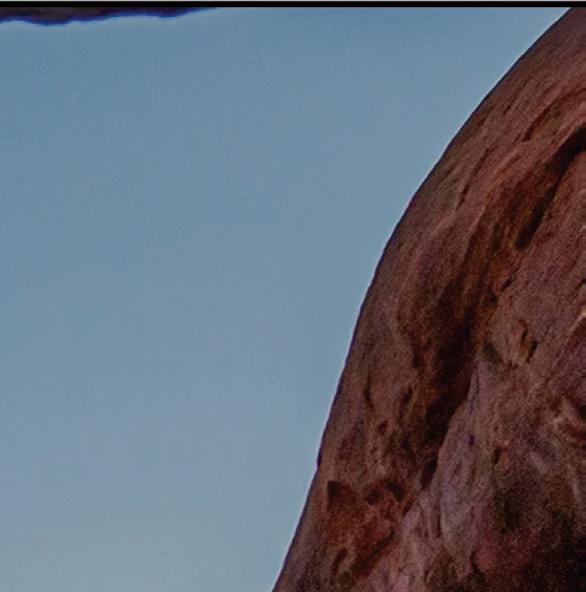






Kai is a 19-year-old student, who feels overwhelmed and manipulated by repetitive content. He seeks to understand the world from diverse, even opposing, viewpoints and desires a fresh way to access information. Additionally, he is looking for a way for friends to share insights and collaborate remotely.

“Thought Matrix” offers five key features to address this.

First, it guides exploration through stories and choices in different chapters. Kai makes intuitive decisions; each choice is not about right or wrong, and each connects to relevant knowledge for learning.






















































































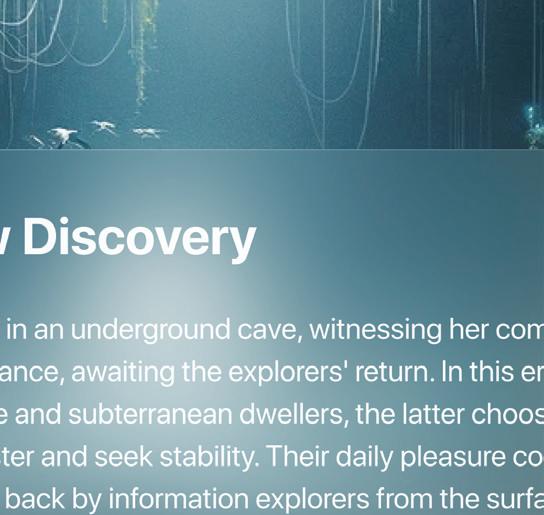



















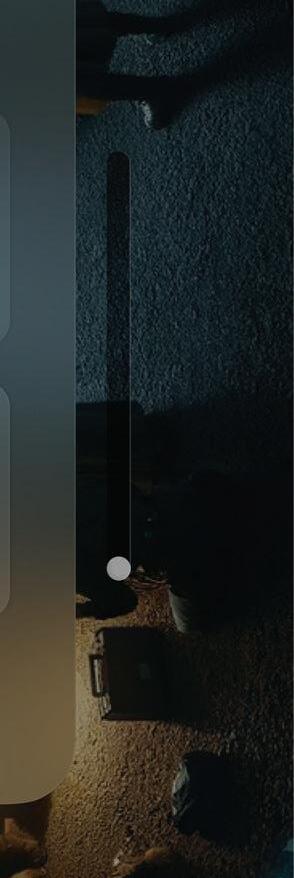




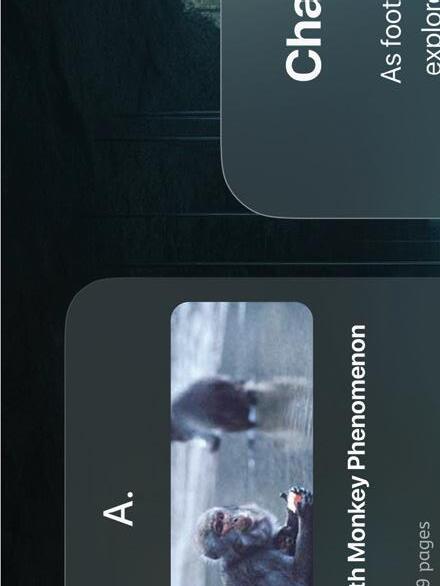






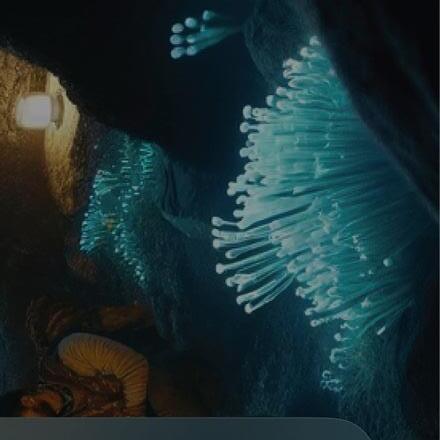








Kai sees others who made similar choices, like philosophers, authors, or writers, offering multiple viewpoints. After he goes through these resources, he can choose to record his thoughts if he has any insights in mind. He can also record his thoughts or skip to the next chapter.



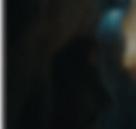










































































































Kai can explore opposing perspectives by changing his choices. In this example, Kai can not only explore philosophers’ ideas but also view user-contributed knowledge. This variation in outcomes piques his curiosity and allows him to revisit scenarios to explore different insights through new choices.
















































































the “Companion on the Road” page lets Kai track his friends’ progress and join them for discussions. For instance, Kai can join Zion’s journey, meet three participants there, and opt for calls or video chats if divergent answers arise.
















































































Another feature allows Kai to explore a friend’s thoughts if they’re offline. By selecting the “Skip to the corresponding Chapter”, Kai can access chapters with different choices made by his and his friend, encountering new content.











































































































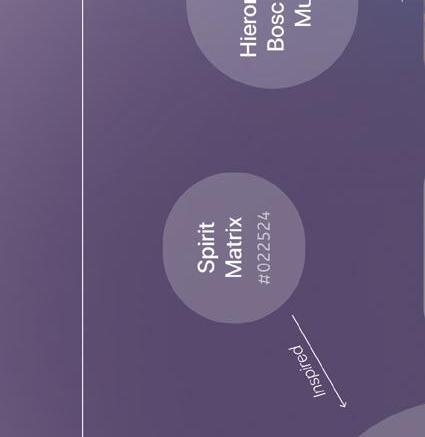













After he finishes his adventure, he can review his thinking process through his Thought Matrix and check the relevant references by clicking on the bubbles.

























Background images: Whittlesea, I. (n.d.). Becoming invisible. http://www.mottodistribution.com/shop/becoming-invisible-ian-whittlesea-the-everyday-press-9780956173898.html

I conducted user testing with 25 participants who provided positive feedback. They suggested adopting this format in future classrooms, noting its appeal to young people and its ability to foster critical thinking and intuitive decisionmaking. One of the 12-year-old middle school students said, “This will definitely help somebody to understand it more. And I think that’s a great way to show them what is all about.”4



“It can be suitable for young adults, high school, and early undergrad. I would say between 17 to 30.”
Marcos Escamilla-Guerrero1“High school would love this. But some people, probably 20s 30s, who would also love this”
“If there was a scale, I’d say 10. There were definitely a lot of options that were given to me like, different readings, that target different genres that they were all interesting.”
Gena Lakin2“If you get something wrong, it’s okay. Because the users can always make another decision. It helps people to do critical thinking.”
Yao Yao3“It is like a huge fragment into the smaller ones.”
“This will definitely help somebody to understand it more. And I think that’s a great way to show them what is all about.”
Braven Christensen41. G. Guerrero, M.S.AAD, Cornell University, Apr 19, 2024
2. G. Lakin, M.S.Ed., Apr 17, 2024
3. Y. Yao, Mother, Freelancer, Apr 17, 2024
4. B. Christensen, Student, Gamer, Apr 20, 2024
“It strikes me as something maybe 30 or younger when we use it a lot more just because there are some native interactions. But if you take age out of it you know the people who are very experienced echo files or gamers or people who are used to kind of interactive adventures during their active things like this would adapt to it. And enjoy it.”
“It’s to learn and find different things to discover different things. There’s somebody that’s not been exposed to the things that you’re showing, right? They don’t know the music or the books or the people that you’re talking about in this. they wouldn’t be able to understand this and it would actually be like, as you’re presenting it, it aligns well with people who are used to do anything in the gaming environment. So they wouldn’t have to learn the tool to then learn your information. This would be very native to them, and make that easy for them to focus on what you’re telling them well, where do I go here? How do I get there? So that’s a that’s a big plus. And that’s where you always want to be at is don’t make don’t make people figure everything out. Give them a platform that’s easy enough for them to move through that they attend to the information.”
Paul Gilbert5“There’s no right or wrong. It’s like going with what you resonate with. And it shows you, other thinkers, from the past, or writers, what they like, it made me feel connected to the people that you were showing. I felt like close to them.”
“Learning these ideas or these writings from these thinkers is much more interesting and fun than just reading the book. It’s definitely more interactive than just doing the homework.”
Rocio Cumplido65. P. Gilbert, Sky Factory, Digital Marketing Leader, Apr 17, 2024
6. R. Cumplido, MFA Fine Arts, Otis College of Art and Design, Apr 21, 2024
“This is a medium that I think younger people will resonate with.”
“In a recent Lighthouse event at The Center for Conscious Design, Upali Nanda, Global Section Director of Innovation at HKS Architects, noted that machines are all about processing data, analyzing it, and giving you the answer. Everything about digital media is about interaction, feedback, and measuring what you do, but measuring does not provide understanding and much less self-understanding. Because humans need time. We need time to reflect, assimilate, and empathize before we can understand ourselves and others. ”
Upali Nanda said, “Design should help people slow down and really think.” She asked the audience: “‘What does it mean to be human?’”
“Younger people see reality as ‘How many followers do I have? How many likes can my posts generate?’ Before the internet, we didn’t have to deal with all that. Only our close friends were our audience. Today a person’s posts can reach hundreds, thousands, or even millions of complete strangers. Therefore, it’s very difficult for younger people to know what’s real.
Through engagement algorithms, social media platforms distort what’s real, what’s important, what’s relevant, and everybody feels the presure to compete and be the shiniest thing on the Internet. It’s difficult to unplug and be at peace in your own space, thinking about things that might be important to you, that mean something, and that perhaps don’t need an audience.”
David Navarrete77. D. Navarrete, Sky Factory, Director, Apr 17, 2024
“I immediately understand what’s happening. I feel like I’m self-reflective information that helps me understand my own. type my own way. of thinking.”
“I think children would be fascinating because television was initially conceived with the idea that it could be a wonderful resource for education. It’s turned out to be something like exploiting our vices. We developed this consumer culture and people are creating these desires and killing us with desire which means selling need rather than using it as a medium for learning. And so I’m excited because I think that media has a lot of potential for a good purpose like education for children. So I like children like this can easily be configured to is to satisfy children, as well as adults because I had a nice like, for a few minutes there.”
“I love the idea that you are using technology for this because in critical thinking knowledge, teaching yourself things, checking your perceptions as others, and relying on credible sources that are universally accepted is a great thing that humanity needs right now. Where I think that there are these epistemic bubbles or silos where I’m only going to trust the information I get from this source or that source and just ignore the rest. There’s a big problem because they’re just as and it’s hard to know what’s true anymore. But, this is the emphasis and some learning about current events. It’s more about enriching the human experience. So I think that the teleology of this universe has universal appeal because it does not. It’s not as the goal isn’t to steer you in a direction other than human enrichment. There’s something good for everybody.”
“This one was really interesting. It’s definitely another perspective. And I’ve never seen a platform like this before. It was engaging”
“If this platform is in a school, for exploration, instead of slideshows. You would offer this as a teacher.”
“It’s fun and engaging and creative. It helps the user be able to absorb information better because it’s not dull and boring.”
“Actually, when I first felt it was like Plato’s cave, my thought was ‘Oh, it must be really interesting.’”
“Making choices based on my intuition is good, and it allows me to focus on the information I’m curious about.”
“I would pay to subscribe to this.”
“This game is very good and very interesting.”
9. K. Sarah, Student, Apr 17, 2024
10. L. Catherine, MPS in AEM, Cornell University, Apr 20, 2024
11. Y. Jing, Dual MBA, MPA, Cornell University, Apr 20, 2024
12. A. Rui, Student, Artist, Apr 25 2024
“What you need to do from a purely practical UX perspective is to tell people that this is, what is expected of them, and that they’re gonna be safe this whole time. You inform them: you can sit down, you can stand up, and you can have water. You can stop at any time, if you need to and take a break. Usually, it takes about 5 to 10 minutes. You’re taking them on a journey and they need to know what to expect. This is why we pointed out the direction they need to have something that tracks like you’re approaching the end. I also want to know if there’s an accessible home button to backtrack if needed. I want to know that I can always leave this journey. In this way, you show care for your user. So they feel safe, and they can leave and come back at any time.”
“Maybe I want to do this when I eat breakfast in the morning when I’m drinking coffee and it’s like I have five minutes and I want to get a dose of inspiration for the day, like reading my horoscope.”
“People can have their decision-making or personal life philosophy style identified as part of this journey. For example, someone can earn the title of a “dreamy version of Freud: or “Simone DeBeauvior’s bestie.”
“For the people who are in my friend group, you can see who in your group follows rules or likes to take the biggest risks. That’s interesting. I would like to know who’s the most adventurous, who’s the most intellectual. You can see how this might be helpful because then you get to know your friends better and then you know how to rely on them, maybe there’s someone better for different advice. That’s the point of this, but there’s no right or wrong.”
“Everybody has a different strength. And we can all be different and valuable, and maybe that’s at the core of your political statement. It’s not about choosing the red pill or the blue pill. It’s like, how do we help each other based on the kinds of choices we make?”
Adriana Young13Scan the QR code to start your journey!
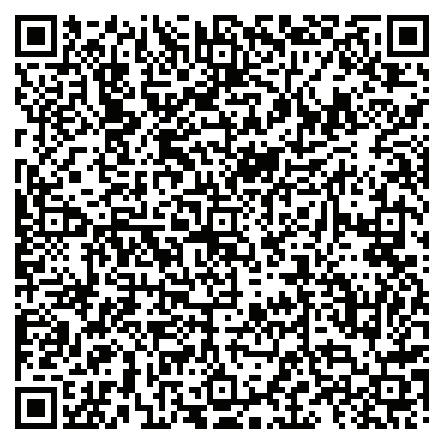
Furthermore, I have expanded the features of “Companion on the Road.” Let me introduce “Kong blocks”.
Kong Blocks embody interactions and achievements from the Thought Matrix.
Users can build upon their learning journey by stacking blocks, each linked to a new resource and mind map within the Thought Matrix.
These blocks serve as visual representations of their learning milestones, like trophies, showcasing their explorations and accomplishments.

































The matter began with a scene from ‘2001: A Space Odyssey,’ which imitates the origin of wisdom. It is absurd, inexplicable, yet inescapable like fate. This strange ‘Monolith’ has been lingering in my mind because of its cleanliness, symmetry, and stability.
























The simplicity and purity of the Monolith stand out in natural landscape because it creates a state of negative space. Its appearance comes from nothing to something. This inspired the naming of my work




In the world of 2080, everyone contributes to a vast knowledge base. In this era, the ability to think is greatly valued, and people upload their thoughts and findings to a space called: Knowledge Base, to build a civilization of wisdom.
Zoe, born in 2062, is an information hunter, dedicated to finding information scattered across various dimensions and uploading these information to the Knowledge Base. Zoe does not have “parents” in the traditional sense; she was born from an AI womb, which has become the norm in her time. In this era, nearly 80% of people come into the world in this way. Thus, everyone is not only family but also friends to each other, leading to closer and more harmonious human connections.
To cope with the growing population and the limited resources, humans no longer have fertility through their bodies. Most of the population are born from AI wombs. This not only reduces the health risks and mortality associated with childbirth but also brings more stability and the possibility of sustainable development to society.
In this era, every child receives a complete set of brain exercises and thinking training from a young age. This education system is uniform globally, ensuring equal educational opportunities for every child. Though the content of education is standardized, it does not limit the diversity of their thinking. The initial purpose of this system is to cultivate children’s thinking abilities, and as they grow older, they are free to choose their fields of interest for in-depth study.
Human society in this era is free of lies, corruption, or war, as information is completely transparent and shared. In such an open information society, people trust and respect each other as a group.
The society is divided into three levels:
Information collectors and learners (the first level), Information organizers and verifiers (the second level), Summarizers and producers (the third level).
These three levels cooperate, driving rapid social development. In this society, each level has its unique value and importance, and no one feels proud or inferior because of their level.
To address the threat of the sun’s destruction to Earth, humans had long ago started the Earth Travel Plan. Today, Earth’s journey has brought them to a star system with nine stars. The existence of this star system poses a great threat to Earth, as these stars could potentially scorch Earth to oblivion.
At this time, Zoe is busy searching for information to prevent this disaster. She travels through different dimensions and spaces, looking for key information to solve this crisis. During a space-time journey, Zoe gathers two scholars from different times and spaces. They sit down, each taking out their Connect Cards and inserting them into slots, activating their thought matrix. After they exchange their information, Zoe finds a possible solution.
The inspiration for this solution comes from an ancient Chinese myth. In this story, there were once ten suns in the sky, and people on Earth suffered from extreme drought. A mythological Chinese archer, Hou Yi shot down nine of the suns, thereby saving life on Earth. Zoe brings this information back to 2080 and uploads it to the second level of the Knowledge Base. Ten days later, experts in the third level find a way to replicate Hou Yi’s mythical arrows and successfully push eight of the stars away from Earth.
During this process, Zoe realizes that despite how times change, humanity’s wisdom and creativity are always its most precious assets. Zoe’s work does not end there. As an information hunter, she knows countless unknown pieces of information are waiting for her to discover and explore.
The term “ 空 ” (Kong) in Chinese can mean “space,” “emptiness,” or “atmosphere.” I want to express the feeling of creating things in a space, exchanging knowledge with friends, and starting to think from nothing.





































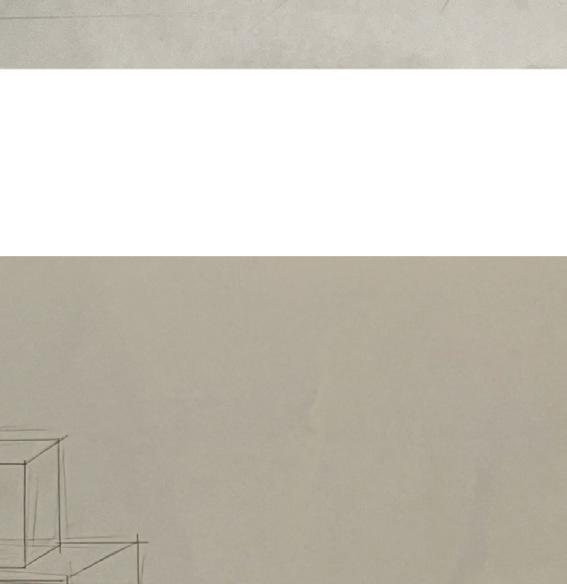

















































































































































































Imagine a couple of generations into the future with the Apple Vision Pro headset.

Scan the QR code to observe how it works.

You deserve to be heard






Factors such as a significant decline in the quality and quantity of social interactions and intense attention to the social status of an individual in a group, some considerate social standards explicitly in eastern setting, socio-cultural factors, fear of being ridiculed during expressing an opinion, epistemic belief in the certainty of knowledge
Mohammadi, M., Abbasian, G., & Siyyari, M1The very choice of which social media they use often reproduces class and racial/ethnic inequalities through what boyd (2011) calls a process of online “self-segregation.”
Brough, M., Literat, I., & Ikin, A2
Investigations by journalists found that Facebook advised advertisers on how they can target vulnerable teenagers, as young as fourteen, at moments when they feel “worthless” and “insecure”. This is achieved by “monitoring posts, pictures, interactions and internet activity in real-time”, which allows Facebook to know when teenagers “feel ‘stressed’, ‘defeated’, ‘overwhelmed’, ‘anxious’, ‘nervous’, ‘stupid’, ‘silly’, ‘useless’, and a ‘failure’.”
Sahebi, S., & Formosa, P3
Studies show that the more time teens spend on social media, the worse their mental health is. The gradient is steepest for girls, who also spend much more time on social media than boys, explaining the sharper deterioration among girls’ mental health than boys’.
Burn-Murdoch, J4
The report found that kids on social media are often exposed to extreme, inappropriate and harmful content, and those who spend more than three hours a day on social media face twice the risk of poor mental health, including depression and anxiety.
Orlando Sentinel5
Teenagers (14-18) today face a myriad of challenges. These challenges making them consuming and not creating the information, they are not expressing their own voice.
1. Mohammadi, M., Abbasian, G., & Siyyari, M. (2022). Adaptation and validation of a critical thinking scale to measure the 3D critical thinking ability of EFL readers. Language Testing in Asia
2. Brough, M., Literat, I., & Ikin, A. (2020). “Good Social Media?”: Underrepresented Youth Perspectives on the Ethical and Equitable Design of Social Media Platforms. Social Media + Society
3. Sahebi, S., & Formosa, P. (2022). Social media and its negative impacts on autonomy. Philosophy & Technology.
4. Burn-Murdoch, J. (2023). Smartphones and social media are destroying children’s mental health. FT.Com
5. We must protect students from social media harm guest columnist. (2024, Jan 21). Orlando Sentinel





Unity Canvas is a service design platform aimed at teenagers, transforming their creative expressions into shared value across digital spaces. It showcases their creativity through Times Square’s digital billboards, allowing teenagers to transcend boundaries. This platform amplifies diverse voices equitably, through time and space.
A digital exhibition designed to democratize the expression of creativity, whether it’s a reflection, discovery, poem, painting, artwork, or song, is given equal prominence.
1. Theme Selection and Kit Distribution:
Each exhibition is centered around a specific theme that encourages creativity. Participants receive kits upon registration, guiding them through the preparation and submission processes.
2. Preparation and Exploration:
Participants, specifically teenagers, utilize the kit to prepare their submissions. This includes following instructions, understanding guidelines, and familiarizing themselves with the submission process.
3. Submission and Curation Period:
After submitting their works, creators await the curation outcome, which takes approximately three months, during which preparations for the event are made.





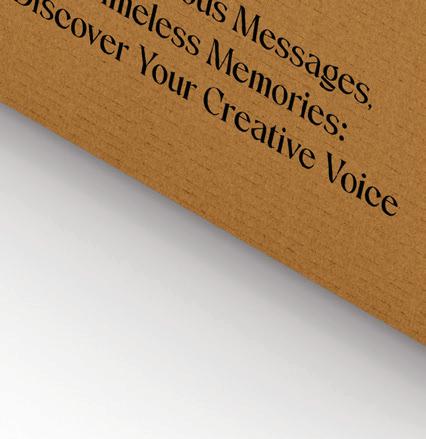








Go to Page 183 to check the related project: Drifting Canvas
Participants' works are showcased in an immersive, large-screen environment, such as Times Square. Their works will be presented equally at the same time and in the same space. The exhibition extends to digital platforms, allowing viewers worldwide to engage and participate in this global community event.





Following the exhibition, participants reflect on audience feedback, connect with other creators or viewers, and are encouraged to submit new works for future events, fostering ongoing engagement and community growth.


Participants can observe audience reactions directly via cameras positioned near the display screens, capturing real-time responses from the crowd.
Feedback, including comments, will be seamlessly delivered to participants' phones, with notifications automatically appearing on their screens for immediate viewing.
The system will filter out unhealthy, insulting, and negative comments to prevent harm to teenagers.
What if a teenager doesn’t realize he or she needs to express themselves?
By publishing advertisements for the exhibition on social media, we encourage parents to bring their children to the exhibition site. This allows their children to see that teenagers of their age can also showcase themselves.
The service bridges digital submissions with physical displays, creating a unique hybrid environment that combines online interaction with real-world engagement.
Information Exchange
Details about the artworks, stories behind the creations, audience feedback, and appreciation, fostering a deeper connection between creators and viewers.
Physical Objects
The large digital screen used for the public dis play of artworks.
Unity Canvas Features
Supportive and Equal Environment
Positive Digital Space
Free Expression without Judgment
Diversity and Broad Understanding
Unity Canvas envisions a future where adolescents engage in a digital ecosystem that nurtures creativity, fosters inclusivity, and promotes mental well-being, transforming the landscape of online interactions into a vibrant, supportive community grounded in respect and understanding.










Drifting Canvas kits are designed to practice vulnerabilities and boost creativity among teenagers. These kits provide a distinct journey through creativity, fostering connections and self-expression in three steps: initiating conversations with friends on shared interests, discovering and documenting treasured family narratives, and engaging in community activities for fresh experiences. Each stage is designed to inspire users to gather inspirations, and to create artworks that reflect their journey and connections across friends, family, and strangers.
This product offers a unique opportunity to bridge the gap between individual expression and communal connection through creative design. It’s a chance to empower those often overshadowed voices, particularly introverted students, enabling them to share their stories and creativity in a meaningful way.
“Even in high school, it could be seen that they didn’t quite understand social cues and being able to socialize with their peers, and having normal conversations because they were so used to being on their phones, and different social media sites.”
“They didn’t quite understand social cues or be able to socially interact with their peers that you would expect them to know.”
“I honestly do think that it has to do with the social media and like the instant gratification, the tech accessibility and just not being able to decompartmentalize and say, because this isn’t on technology, and a lot of the curriculum was still paper pencil, through textbooks, and because there wasn’t tech involved. They weren’t as focused or really confident about what they were doing.”
Gena Lakin 1“Critical thinking is at least half of feeling... insight is not all logical. Let’s say you’re reading something difficult and you don’t understand this. So you look at what other people say or summarize. As soon as you do that, it’s gonna be very difficult for you to actually feel your own reactions because you have someone else’s ideas in your mind about what you should feel or what everyone else feels or something like that. And I think it’s very limiting.”
“I think students need to learn to trust their own reactions rather than think, ‘I should be reacting to how that person has.’” To build up trust in our reactions is crucial for fostering confidence. Once we trust our feelings and take a step into the realm of experimentation, we will experience motivation, failure, revision, and testing, and eventually, we will harvest the results. This states a healthy loop for individuals to trust their thoughts, rather than allowing others’ thoughts to overweight their original ideas.
Peter Thomas2
“What I think is still very important is to have these machine learning algorithms that are not really good at creating mental models or creating learning. What are the important things to debate? What are the important things that trigger people’s emotions? Because the difference right now is that we, as humans, still have the capacity to feel...an artist will become an artist, because of his history and how he’s enabling himself through all these tools to reproduce this history, and how people can connect, have compassion, and empathize and be inspired by this history. And this is something that a robot or artificial intelligence will never have because it doesn’t have the sense of pain, or the sense of love.”
Pau Garcia31. G. Lakin, M.S.Ed., March 04, 2024
2. P. Thomas, School of the Art Institute of Chicago, Instructor, October 27, 2023
3. P. Garcia, Domestic Data Streamers, Founder, November 15, 2023
Learning should begin with feelings, and we should at least go through a process of feeling or struggles to reach the results. Then we organize the process and might eventually label it as “logic”.
How might we inspire teenagers to value their own ideas, share their stories, and build relationships with others, therefore promoting independent thinking?

Dri ing Canvas kits help teenagers to enhance creativity and forge authentic connections. rough self-directed activities, users gather personal stories, create re ective drawings, and discover others’ experiences through their Dri ing Postcards.


Begin with a simple self-introduction template. Allow users to express themselves.

























Encourage participants to collect items related to personal experiences or emotions, not limited to ticket stubs or photos, but also including notes written with special days or small items representing specific memories.

























Transform the memories into a tangible form of expression on the Drifting Postcard. Whether through words or images. This step is about turning the memories into a beacon for connection and inspiration.

























Place the postcard in a location that the participant finds meaningful, and write the hiding spot on this card.























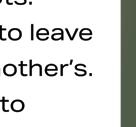

















Scan the QR code to observe how it works.

“Compared to location recommendations on Yelp and Google, postcard sharing from strangers sparks my desire to explore even more!”
“I thought some memories were too personal to share. However, after I collected my items, I realized I had so many things worth sharing. The joy outweighs my embarrassment and vulnerability.”
Quotes from participants
During this process, most people realized that recalling past items and expressing themselves in this way is very precious. It also reminded them of past smells, songs, and places, memories that might not have been uncovered if not for this opportunity.


For my next step, I will continue to add new plots and resources to Thought Matrix, making the story richer. I particularly liked one participant’s suggestion:











“I hope I can choose both the red and blue pills, or maybe there’s a pink pill or something.”
This has shown me more interesting and even unexpected possibilities to explore new plots and relative references.


Brough, M., Literat, I., & Ikin, A. (2020). “Good social media?”: Underrepresented youth perspectives on the ethical and equitable design of social media platforms. Social Media + Society, 6(2). https://doi.org/10.1177/2056305120928488
Burn-Murdoch, J. (2023). Smartphones and social media are destroying children’s mental health. FT.Com. Retrieved from https://www.proquest.com/trade-journals/smartphonessocial-media-are-destroying-children/docview/2785107791/ se-2
Garcia, P., & Truong, T. (2023, March 6). How we used Barbie dolls to hack AI bias. Medium. https://domesticdatastreamers. medium.com/hacking-ai-biases-with-barbie-ken-a2f3256cf113
Marzia, A. (2022, December 8). Gen Z is ready to torpedo social media’s echo chambers. The Daily Beast . https://www. thedailybeast.com/gen-z-is-ready-to-torpedo-social-mediasecho-chambers
Mohammadi, M., Abbasian, G., & Siyyari, M. (2022).
Adaptation and validation of a critical thinking scale to measure the 3D critical thinking ability of EFL readers. Language Testing in Asia , 12(1). https://doi.org/10.1186/ s40468-022-00173-6
Munger, K. (2023, December 8). Kevin Munger on Vilém Flusser’s “Communicology: Mutations in human relations?” YouTube . https://www.youtube.com/watch?v=EpVTEoqUCbs
Parker, L., & Smith, K. (2022). Literacy education in the post-truth era: The pedagogical potential of multiliteracies. Language and Literacy / Langue et litteratie , 24(2), 198-215. https://doi.org/10.20360/langandlit29577
Phillips, W., & Milner, R. M. (2021). You Are Here: A Field Guide for Navigating Polarized Speech, Conspiracy Theories, and Our Polluted Media Landscape . The MIT Press.
Rieh, S. Y., & Hilligoss, B. (2008). College students’ credibility judgments in the information-seeking process. In Digital media, youth, and credibility (pp. 49-72).
Sahebi, S., & Formosa, P. (2022). Social media and its negative impacts on autonomy. Philosophy & Technology , 35(3). https:// doi.org/10.1007/s13347-022-00567-7
Scott, R. M. (2023). Managing misinformation on social media: Targeted newsfeed interventions and freedom of thought. Northwestern Journal of International Human Rights , 21(2), 109-184. Retrieved from https://www.proquest.com/ scholarly-journals/managing-misinformation-on-social-mediatargeted/docview/2836996971/se-2
Scott, R. M.-G. (2023b, October 24). The algorithmic management of misinformation that protects liberty. Tech Policy Press. https://www.techpolicy.press/the-algorithmicmanagement-of-misinformation-that-protects-liberty
Should anxious teenagers be banned from using social media? (2023, April 6). Irish Times. Retrieved from https://www. proquest.com/newspapers/should-anxious-teenagers-bebanned-using-social/docview/2795829717/se-2
We must protect students from social media harm. (2024, January 21). Orlando Sentinel . Retrieved from https://www. proquest.com/newspapers/we-must-protect-students-socialmedia-harm-guest/docview/2916846146/se-2
On the internet, there’s a fine line between fun and manipulation. (2023, July 26). Irish Times. Retrieved from https://www.proquest.com/newspapers/on-internet-there-sfine-line-between-fun/docview/2841615834/se-2
A. Rui, Student, Artist, Apr 25 2024
B. Christensen, Student, Gamer, Apr 20, 2024
B. Westgerdes, Sky Factory, Standards Coordinator, Apr 25, 2024
D. Navarrete, Sky Factory, Director, Apr 17, 2024
G. Guerrero, M.S.AAD, Cornell University, Apr 19, 2024
G. Lakin, M.S.Ed., March 04, 2024
G. Lakin, M.S.Ed., Apr 17, 2024
K. Sarah, Student, Apr 17, 2024
L. Catherine, MPS in AEM, Cornell University, Apr 20, 2024
P. Garcia, Domestic Data Streamers, Founder, November 15, 2023
P. Gilbert, Sky Factory, Digital Marketing Leader, Apr 17, 2024
P. Thomas, School of the Art Institute of Chicago, Instructor, October 27, 2023
R. Cumplido, MFA Fine Arts, Otis College of Art and Design, Apr 21, 2024
Y. Adriana, Mother &Educator, School of Visual Arts
Y. Jing, Dual MBA, MPA, Cornell University, Apr 20, 2024
Y. Yao, Mother, Freelancer, Apr 17, 2024
Thank you to everyone who has helped, inspired, and supported me during my thesis journey. Thank you all.
Mom
Dad BrotherMinchun Liu
Katie Zhu
Yao Yao
Rocio Cumplido
Jamie Chen
David Navarrete
Ben Westgerdes
Peter Thomas
Kong kong (my cat)
Rui
Braven Christensen
Feiga Law
Kairong Wu
Jianing Qi
Adriana Young
Garrett Laroy Johnson
Gena Lakin
Yue Liu
Pau Garcia
Anne Quito
Hugh Francis
Priscila Zhang
Sarah Kazakis
Jing Yuan
Catherine Lin
Aubrev Nolan
Pea Pods
PoD Faculty
VFL Faculty
Bill Witherspoon
Paul Gilbert
Lanqing Xu
Kwunkwan Ting
Amogh Gharpure
Yin Wu
Xincheng Li
Id
Ego
Superego
Myself